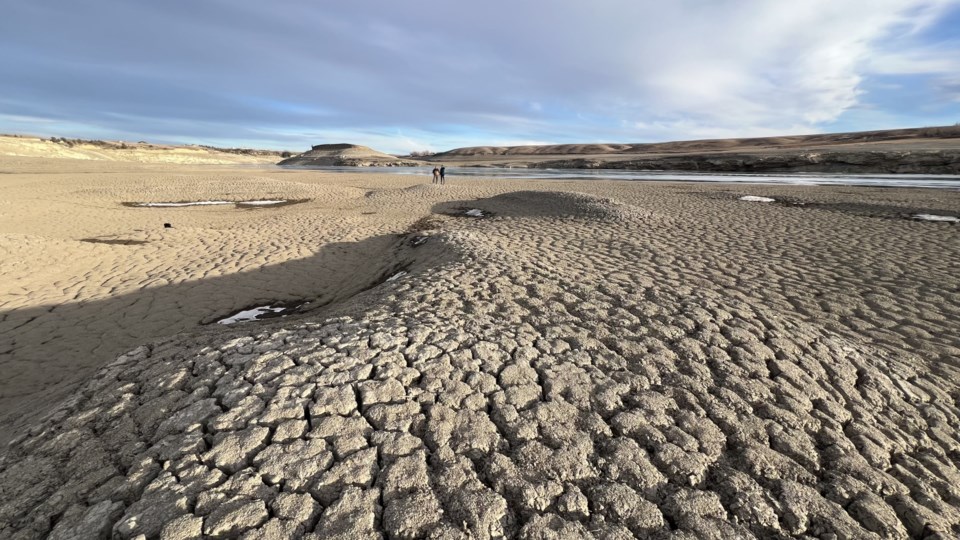As prolonged drought conditions persist in the region, the MD of Pincher Creek is closely monitoring the Oldman Reservoir, a vital water source for local communities. Water levels remain below historical averages, raising concerns about potential shortages.
Monitoring and water management strategy
David Desabrais, utilities and infrastructure manager for the MD, acknowledges challenges posed by ongoing drought conditions in the region and provides insights into the current state of the reservoir.
Speaking with Shootin’ the Breeze, he says the reservoir level is lower than historical averages for this time of year, but remains significantly higher than in 2023, when the region faced a severe water crisis.
Desabrais emphasizes that while the MD is keeping a close watch on conditions, it does not control reservoir levels, which are managed by Alberta Agriculture and Irrigation based on the needs of downstream users.
With concerns about potential drought conditions as summer approaches, Desabrais notes the importance of monitoring snowpack levels, which typically increase until mid May.
“It’s still very early to say what runoff conditions are going to look like come middle or end of May and into June, because we still have a lot of time to develop that snowpack,” he says.
The MD has installed new water intakes, providing additional resiliency if another significant drought occurs. However, these measures do not impact the natural flows of the headwaters or the effects on wildlife.
While the MD has no direct control over reservoir management, Desabrais says it can advocate for its needs if excessive downstream withdrawals threaten local supply.
Water restrictions could be implemented if reservoir levels fall below the intakes used by municipal systems, though he says the MD does not anticipate restrictions as severe as those imposed in 2023 and 2024.
According to data provided by the MD, total municipal raw water usage in 2024 was 101,828 cubic metres.
The Oldman Reservoir currently has about 278 million cubic metres, with less than 0.04 per cent used in 2024.
Desabrais emphasizes that the MD’s water withdrawals have a negligible impact on overall reservoir levels.
Even in the extreme scenario of no incoming water and no releases downstream — one Desabrais says is theoretically impossible — the MD’s annual water use would take over 2,700 years to deplete the reservoir.
To put this in perspective, Desabrais notes that the MD’s annual water usage is equivalent to the amount of water released downstream every six hours. During peak summer months, outflow rates can reach 150 cubic metres per second, further illustrating how minimal the MD’s consumption is compared to overall reservoir activity.
Desabrais reiterates that while the MD remains vigilant in monitoring water levels and advocating for fair water distribution, ultimate control of the Oldman Reservoir remains with Alberta Agriculture and Irrigation.
Rising concerns from residents
Despite reassurances from the MD, some residents remain uneasy about the reservoir’s declining levels and the potential for stricter water restrictions.
MD of Pincher Creek resident David McIntyre, who closely monitors the situation, has noted significantly reduced river flows in the Crowsnest and upper Oldman rivers.
“I have been watching the rivers and noticed they are very low,” McIntyre says.
He also points to a recent advisory issued by the Government of Alberta as evidence of the severity of the situation.
“When I checked the water-flow data last week, I saw that the province had issued a water shortage advisory for these rivers,” he says.
“I could also see from the data the outflow from the dam and my concern was that we might be facing the need to reinstall a costly water pumping system at the reservoir, like we did before.”
According to McIntyre, the MD of Pincher Creek has confirmed that while water levels are low, there is currently about 2.5 metres of freeboard — the remaining depth from which water can still be pumped.
“I have a concern that if the MD is caught in that same type of thing, there will be incredible pressure on the government to not release what would be the critical, sustained flow [of water] that the Oldman River gets out of the dam,” McIntyre adds.
“My concern is that the downstream waterway might not be getting the water to sustain life.”
Beyond water levels, he is also alarmed by the provincial government’s decision to allow resource development in the headwaters, an area crucial for sustaining river flows.
“My concern is made worse by the fact that the province is now opening the headwaters to investment companies like Northback, allowing them to further disturb these critical water sources,” McIntyre says.
The MD continues to monitor conditions, but as summer approaches, both officials and residents will be watching closely to see how water levels evolve.



